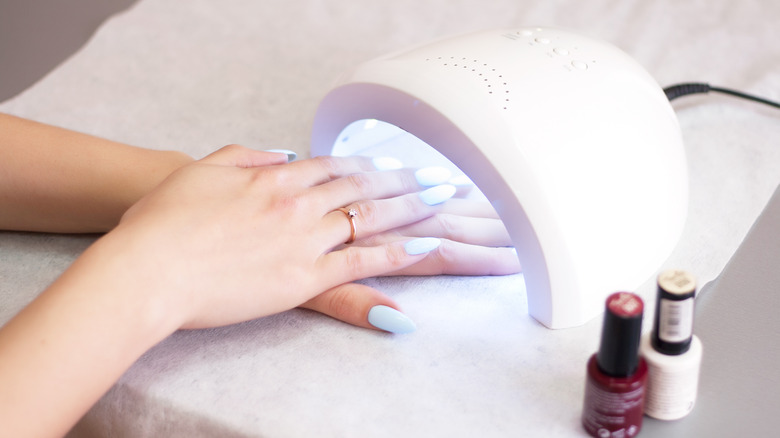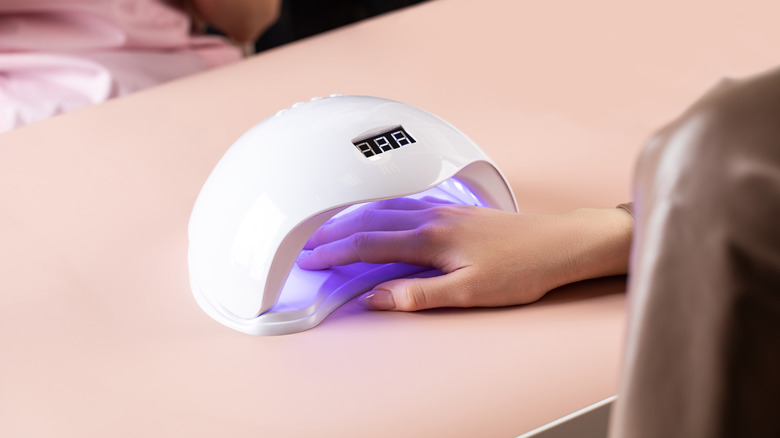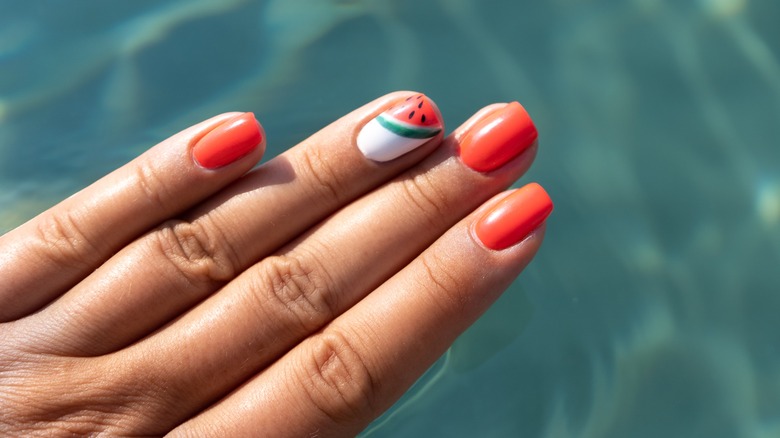UV Nail Polish Dryers Are Sparking Serious Health Concerns
If you've ever gotten a gel manicure before, you know that part of the process is running your hands underneath a UV nail polish dryer. This step is vital to setting the gel polish onto the nail and keeping the polish from chipping easily. The UV process typically lasts between 30 seconds and two minutes. In the end, it gives you glossy, sturdy nails. Gel manicures are often preferred over regular nail polish because the hardening process makes them last longer than just a few days. Once your gel polish has set, your designs and color will stay locked in until the natural process of chipping starts. For any nail lover, getting gel manicures is no big deal.
Outside the removal process, there are generally few, if any, complaints about gel nails. The removal process involves buffing your nails and soaking them in acetone. Other than being tedious, the removal process can dry out your hands and damage your nails. During the removal, your natural nails can also peel, leaving your nails fragile and brittle. Although the health concerns about the gel removal process are well known, there's little discussion about UV nail polish dryers. Now, though, a recent update has created a new conversation over the safety of these dryers and whether or not we should still be using them.
The risk of UV nail polish dryers
Besides keeping your hand completely still, there's a more significant reason to avoid a UV nail polish dryer. According to a recent study published in Nature Communications, there is evidence that links the use of UV nail polish dryers to an increased risk of cancer. The results of this study found that those who frequently use these UV dryers are left with damaged DNA. While it doesn't mean every use of UV dryers will lead to cancer, there is a mutation of the cells that occurs after each use. While there was always concern about exposure to UV light, specifically with tanning, this is one of the first studies to focus on UV nail dryers specifically.
In a statement to Phys.org, Ludmil Alexandrov, a professor of bioengineering and corresponding author of the study, explains of the study's results, "We saw multiple things: first, we saw that DNA gets damaged. We also saw that some of the DNA damage does not get repaired over time, and it does lead to mutations after every exposure with a UV-nail polish dryer. Lastly, we saw that exposure may cause mitochondrial dysfunction, which may also result in additional mutations. We looked at patients with skin cancers, and we see the exact same patterns of mutations in these patients that were seen in the irradiated cells." Alexandrov summarizes that the mutation patterns found in those exposed to UV nail dryers are similar to those found in skin cancer patients.
Alternatives to UV nail dryers
While it's true that UV nail dryers are the most common way of curating your gel nails, this recent study calls for the use of alternatives. If you want to give your nails a break from the UV dryer, there are plenty of options for getting gel nails without the risk. UV Hero explains that the best alternative to a UV light is to use a LED light. LED nail dryers are much quicker and more inexpensive than UV light. Most importantly, though, they're less risky to your health. LED lights can be found in almost any beauty supply store and are easily accessible. These lamps use light at a certain frequency to set your gel nails and can wind up being a more durable investment than UV lamps.
While uncommon, there's another method that Makeup Muddle suggests for curating your gel nails without the need for a UV lamp. Instead of sticking your hands in a UV lamp, try putting them into a bowl of ice-cold water. The drastic temperature change is also known to help harden your gel nails without needing to expose yourself. This method is easy as all you need is a bowl of cold water filled with ice. Stick your hands in for a few moments and you'll find that your gel nails will harden just like at any salon. Although this method is less mainstream, it's much safer and healthier for you and your nails.


